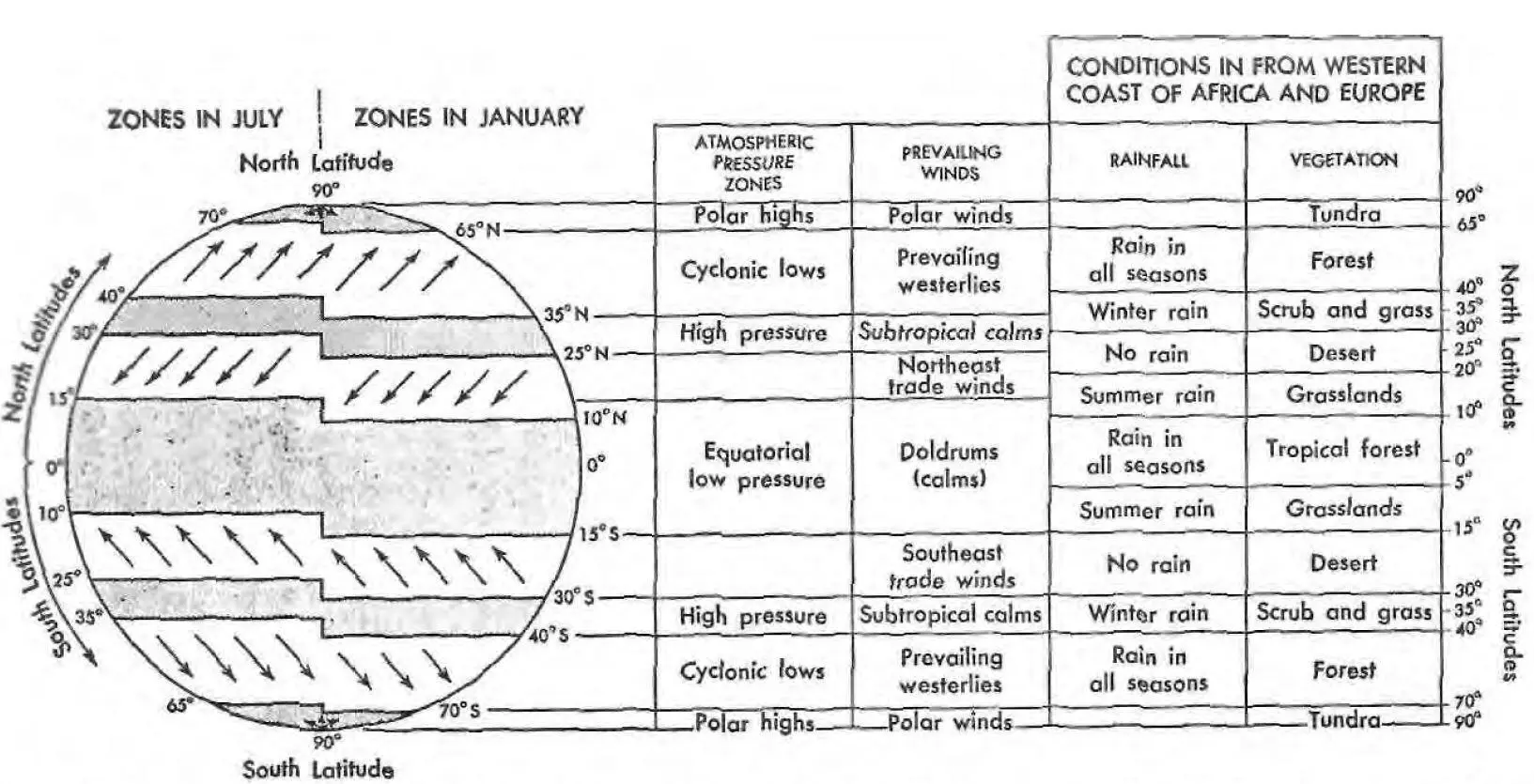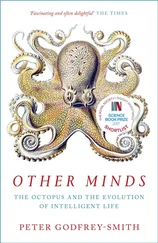
Simplified diagram of the world globe showing the shift north and south of the zones of atmospheric pressure and prevailing winds caused by the annual inclination of the globe between July and January. The two columns on the right show the resulting distribution under present, conditions of rainfall and vegetation at various latitudes along the western edges of Europe and Africa. In the glacial ages the northern polar area moved southward to about 45 o N. latitude forcing the cyclonic rain belt and the winter rain belt southward about 10% so that the two grasslands converged and the desert now found at 25 o N. latitude was almost eliminated.
It is quite true that sea levels were considerably lower during the glacial periods, but it is doubtful that this was ever sufficient to open trans-Mediterranean land bridges, at least for any very long time.
This whole process of population growth and movement was reversed at the onset of a glacial period. In the preceding interglacial age, the population of Europe, especially on the grassy Northern Flatlands, must have reached a maximum because of the adequate supply of herding game animals, while in the Southern Flatlands desert conditions must have reduced grass, animals, and men to a minimum. As the advancing glacier moved southward, preceded by the pluvial zone, living conditions in Europe worsened and population became reduced, either by emigration or by death, while the population of the Southern Flatlands, largely from more successful biological reproduction, increased.
It should be clearly understood that all these great changes took thousands of years and occurred so slowly that the individual persons involved could have had no realization that they were concerned with the processes we have described. They knew nothing of moving glaciers or rain belts and had no glimmering conception that they were one generation in a family line that was migrating successfully or was perishing locally. This is clearly one case where the historical events we describe were occurring to statistical masses rather than to isolated individual persons.
Although migration was only a minor portion of the population changes of the Pleistocene, we may picture the glaciers as a great piston that advanced and withdrew four times, expelling population from Europe as it advanced and sucking it back again from Africa as it withdrew northward. This fundamental but oversimplified picture must now be modified by two other considerations. The first of these arises from the fact that glacial advance came down altitudes as well as latitudes, while the second arises from the fact that such glacial movements were not steady but fluctuating.
When we say that glaciers advanced down the altitudes as well as down the latitudes, we mean that glacial advance not only consisted of a southward advance of the polar icecap; it also consisted of a downward extension of the snow line on mountain peaks. The latter movement, on the northern side of mountain ranges like the Alps, Caucasus, or Himalayas, appeared as a northward advance of ice. More significant for human history is the fact that the lowering of the snow line closed mountain passes while the lower altitudes to the north were still habitable, thus trapping groups of people north of the mountain barriers in the face of the advancing Ice Age. These trapped peoples were able to survive only if they could adapt their social customs to living under glacial conditions. This would have required, as a minimum, the acquisition of fire and the use of clothing. Since these people would have been separated from the main stock of mankind in Africa for a long period, at least 100,000 years, it is almost inevitable that they would have become changed in physical features and that these changes would be those such as shorter neck and limbs, chunkier body, thicker hair, narrower nostrils, protected eye sockets, and other modifications helpful in living under arctic conditions.
The development of such a distinctive type of man did occur, at least once, probably in eastern Asia north of the Himalayas, during the second or third glacial age. This type is called Neanderthal man.
Neanderthal man was so different in appearance from most modern men that no observer would be likely to confuse them. His bodily proportions were quite different, since he had shorter legs and almost no neck. There were other, more technical, differences. His rib bones were rounder, rather than flattened as ours are; he had no real chin or forehead; his eyes were protected by bony eye ridges along the brows; and his head was attached to the front rather than to the top of the last vertebra.
Because of these differences, Neanderthal man is frequently regarded as a different species from modern man, or Homo sapiens. But he is more correctly regarded as a variety, since the critical mark of species difference, inability to interbreed to produce fertile offspring, was not true of the Neanderthal and Homo sapiens types. It is now generally recognized that these two were able to interbreed and leave descendants on those rare occasions when they encountered each other along the margins of their customary habitats.
Such encounters were on the margins of their ranges because Homo sapiens lived under temperate conditions, while Neanderthal man lived under semiglacial conditions. They both lived in Europe but at different times. Homo sapiens retreated to Africa when Europe was glacial, thus abandoning Europe to Neanderthal man, while the latter retreated northeastward toward Asia, where he had originated, as the interglacial period commenced. Just as we associated the movements of Homo sapiens with the movements of a glacial piston that ejected him from Europe or sucked him back from Africa, so we could associate the movements of the same piston with Neanderthal man, who came into Europe with the glacier and retreated with it toward northern Asia when it departed.
Because of the conceit of normal egotism, it is customary to regard Homo sapiens as of higher intellectual capacity than Neanderthal man. This is a matter on which real evidence is scanty, but the evidence that is available would clearly indicate that Neanderthal man was at least as intelligent as Homo sapiens. This evidence includes the following: Neanderthal man possessed both fire and clothing, necessities for glacial living, before Homo sapiens did. He seems to have buried his dead, leaving with the body equipment needed in some future life, at an earlier period, thus giving evidence of an earlier recognition of spiritual values. His tools were frequently made in greater variety and with somewhat greater skill, and include the earliest compound tools (in which the blade and handle were separate pieces). But these achievements, which might be interpreted to indicate a fairly high level of brain power, apparently do not indicate sufficient mental flexibility to permit Neanderthal man to survive the ending of glacial conditions. By adapting his way of life so successfully to glacial conditions and to the pursuit of the great glacial mammals such as mammoths, Neanderthal man made his way of life too rigid to permit him to exist under postglacial conditions when such mammals became extinct.
We have suggested that Neanderthal man developed as an offshoot from the main line of human evolution by being trapped by a glacial age north of the mountains in Asia. We do not know whether the glacier that did this was the second (Mindel) or the third (Riss), but it is clear that Neanderthal man was alone in Europe during the early portion of the fourth, Wurm, glacier.
The fourth glacier had two icy peaks known as Wurm I and Wurm II. The interval between them, known as Achen, occurred when the glacier withdrew part way and then returned with full intensity in the phase called Wurm II (or Buhl). The withdrawal of Wurm I gave rise to the usual population movements that we have posited of a glacial retreat, Neanderthal man withdrawing toward Asia while Homo sapiens began to move to Europe from Africa. With the return of Wurm II, this process was reversed; but this time, probably for the first time, some Homo sapiens groups were able to remain in Europe under glacial conditions by adopting the techniques of fire, fur clothing, and cave dwelling that had been developed by Neanderthal man. Thus, for the first time, especially during the early stages of the withdrawal of Wurm II, Homo sapiens and Neanderthal man came into close biological contact, with consequent interbreeding. This occurred on the fringes of Asia and Europe, north and east of the Mediterranean Sea, and may have occurred south of the sea in parts of North Africa. As a consequence, the early postglacial period found three human types in the Northwest Quadrant, Neanderthal in northern Europe retreating toward Asia, Homo sapiens in the Southern Flatlands moving toward Asia and Europe (largely by way of the Levant), and a mixed group in between, chiefly in the Highland Zone of the Caucasus and Iran. It is probable that we owe the later existence of a stocky, roundheaded, agglutinative-speaking people in the Highland Zone to the existence of this mixed group.
Читать дальше











